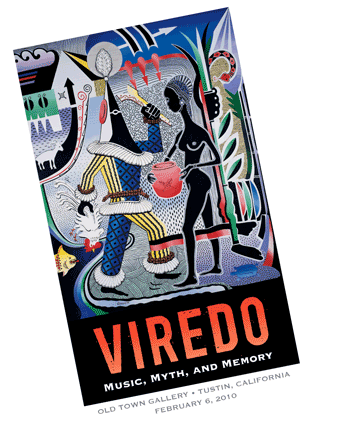
Viredo’s art speaks from the spirit. Memory is his palette. Not the kind of memory that we usually
experience as a linear narrative but an alchemical memory - stirring, roiling, congealing,
collaging, refining. The source of this transformative power is in the raw materials of his past,
of his loves, his passions. They are filtered through his subconscious, at times to sink below
awareness (but never to be forgotten) while at other moments surfacing in vibrant images both
narrative and symbolic. Both are cognitive processes and are analogous to the oneric world of
dreams. He is not rendering a history or attempting to illustrate a specific memory of his life or
of Cuba but to present to us the spirit or to play on Carl Jung’s idea, a collective consciousness.
Surrealism with its ideas about the subconscious, dreams and memory were already a compelling
presence in the world of art in which Viredo came to his maturity. While we see traces of Kandinsky,
Klee, Wifredo Lam, they too are only a palette to be stirred and mixed like the complementary
colors of his paint. Viredo speaks in his own voice. He has developed a style, a visual vocabulary
that is wholly his own.
The figures or perhaps more accurately stated, personas, are iconic and narrative, casual and
profound. Even though I do not share the specific references of his figures and symbols I do sense
a meaning that compels me to look closer. We have mythology itself in common. I don’t believe
in universals, that is, that one symbol will mean the same the world over. However I do accept
Jung’s premise that there are shared archetypes present in human consciousness that manifest
visually, ever new and in differing forms for each generation for each distinct culture. Viredo’s
work allows the possibility of understanding Cuba and perhaps Viredo in a way straightforward
narrative illustrations rarely do.
All figures, in the formal sense of that word, exist against a ground. It’s how we distinguish one
thing from another whether we are presenting dimensional objects or articulating abstract ideas.
Viredo’s grounds are a gorgeous array of interplaying patterns - patterns of simple graphic
designs and patterns of complex symbolism. Pattern translated into musical terminology
is rhythm. Using the same translator, color can be seen as melody. In his paintings melody
dominates rhythm. It is in his graphic works that rhythm is clearly seen/heard. The contrasting
black and white creates a visual syncopation. Perhaps my eye popping in and out, moving
up and down the print’s surface can be seen as a metaphor for snapping fingers and tapping
toes. It is the linocuts that best fuse the figure ground relationship. The eye moves effortlessly
between the two, never resting on any one spot, thus acquiring a temporal dimension found
usually only in dance and music.
To say that the foundation of Viredo’s art is grounded in myth, memory and music is only to
begin the conversation. All art is, or should be a site for dialogue. I invite you to take the time, to
look and listen to what Viredo has to say. You will be uplifted. Your world will be brighter for the
experience.
PATRICK MERILL
